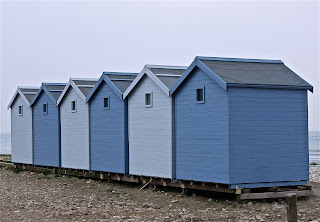Charmouth
When we started the Coast Path in January last year we thought we might eventually get to Weymouth or perhaps even Lyme Regis. Here we are 15 months later about to do the short leg from Charmouth to Lyme and finish the Dorset section. Basically, we are hooked.
We picked up the route at Charmouth's beach car park and admired the immaculate line of six tastefully-painted beach huts. Then we spent a few minutes locating the departure point of the Coast Path (pass the Visitor Centre on the seaward side and turn half right up the slope), pausing to admire the sweep of the beach.
The route to Lyme is rather odd, involving a long-standing, but erratically signposted, inland route. You walk up from the beach to find the main street, The Street, well-named, and follow this west to turn left on the road to Lyme. Just as you think it may be road all the way, you turn left by the Fernhill Hotel uphill through woods and across a golf course to regain the road much nearer to Lyme. After a bit more road and cutting a corner through a bluebell wood, you descend into Lyme down a grassy hillside. Soon, there is a fine panorama, rather misty today, over the town with the famous Cobb to the right.
You rejoin the road again to enter the town centre and pass the rather odd-looking church of St Michael the Archangel. There is evidence of Saxon and Norman construction and the nave dates from 1531. The rather unfinished look is due to a restoration of 1933 which was left incomplete due to lack of funds.
Round the corner, the narrow Church Street is closed by the Guildhall, with the Marine Theatre on the left.
And round the corner is the Museum, an exuberant building of 1901, built on the site of the home of pioneer fossil collector Mary Anning, whose life was novelised by Tracy Chevalier in her novel Remarkable creatures. Rather delightfully, the architect was Thomas Philpot, nephew of Elizabeth Philpot who also features strongly in the novel and in Mary Anning's life.
We followed the Coast Path along the back of Marine Parade, detoured for a wonderful celebratory lunch at Hix Oyster and Fish House ...
... and completed our walk by going to the end of the Cobb.
Conditions: cloudy after early-morning rain and never quite managing to clear.
Distance: 3 miles. Distance covered now 86.5 miles.
Map: 116 (Lyme Regis and Bridport).
Rating: three and a half stars.


















